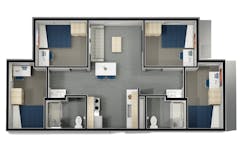Student housing series: Designing a home away from home in The Golden State
Student housing projects serve as home away from home but still need to give the student residents the most authentic collegiate experience. Colleges and universities have embraced the idea of infusing local flavor into standardized principles to create residential facilities specific to that student population.
My recent design work on a student housing project at the University of California, Davis revealed the challenges and restrictions unique to California that make these types of projects unlike others in the rest of the country.
Building codes and regulations
California stands out as a unique market with its stringent building codes. Like other states, California uses the California Building Code (CBC), which is an International Building Code (IBC) modeled code. Unlike other states, the CBC has more additions and restrictive rules and regulations not common anywhere else.
The list of additional restrictions ranges from increased fire apparatus road access to limits on construction type, including some unusual limits on egress. For example, the IBC has long included a provision for sizing windows to allow for emergency egress in small residential buildings with one exit. California extends this requirement to large buildings of several major construction types which precludes using many unit layouts that cannot accommodate larger windows.
California Fire Code also impacts design by limiting building size based on construction type based on the fire-flow calculation area which measures the flow rate of a water supply available for fighting fires. This restriction reduces the allowable building area for certain construction types with impenetrable building separations and prohibits normal building functions like circulation and egress between both sides of the fire wall, which can severely limit program. To account for this constraint, we must either limit our building size or upgrade the construction type to one with a larger allowable fire flow area.
Like other building codes, the state governs accessibility using Chapter 11 of the California Building Code. While other states use ADA Guidelines and IBC’s code language that echoes the Fair Housing Act, California’s accessibility restrictions related to student housing are vast, comprehensive, and complicated. CBC uses Chapter 11A of the CBC to cover private housing and Chapter 11B of the CBC for public accommodations. Student housing on campus is unique because it is classified as transient housing and follows a mixture of both private and public depending on circumstance. Non-accessible units are required to provide for an uncommonly large amount of accessible clearances and adaptability provisions. Getting a feel for these door and appliance clearances and how to use them without producing units that are significantly larger is a particular challenge.
In addition, the number of units required for increased mobility grows depending on the age level of the student residents served, either graduate or non-graduate housing. Typically, the accessibility count is based on the unit count while in California undergraduate housing is by the bedroom.
California housing market
Perhaps the most unique challenge is not created by the increased presence of codes, but by the California housing market itself. Up and down the state, California has one of the highest costs of housing in the country due to the cost of construction, housing demand, increased regulation, and sustainability requirements. These high costs result in increased pressure on reducing the size of units to reduce cost. Unit amenities common in other parts of the country are carefully considered for California units as they make them less affordable. California units frequently use galley kitchens, compressed TV viewing areas, smaller living areas, smaller vanities, more double-occupancy rooms, and armoires instead of closets for more flexible furniture arrangements. The skyrocketing cost of construction labor pushes us to use more prefabricated modular systems that come with a 1-2% increase in area to meet modularity.
Student housing design in California requires a balance between creating an engaging student space with adherence to building codes. The housing market and California’s code come with a set of tough demands, but an experienced design team can create a rich student residential experience anywhere.
This is the sixth blog in a multi-part series on technical aspects of student housing design. Earlier blogs focused on public-private partnerships, important questions to ask when designing a student unit, special-needs spaces, balancing affordability and comfort in acoustical design, and student housing vs. multifamily housing.
About the Author
Stantec
Published by global design firm Stantec, this eclectic blog features viewpoints, insights, and explanations from Stantec architects, engineers, and designers, on a range of issues impacting the fabric of our communities. Our contributors share their thoughts about design trends, emerging technologies, vexing challenges, and inspired solutions. For more blog posts, visit our Ideas page. Follow us on Facebook, Instagram, LinkedIn, and Twitter, and YouTube.

